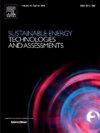Energy, economic and environmental benefits of a car-sharing system with electric vehicles integrated into a renewable energy community
IF 7
2区 工程技术
Q1 ENERGY & FUELS
Sustainable Energy Technologies and Assessments
Pub Date : 2025-06-30
DOI:10.1016/j.seta.2025.104428
引用次数: 0
Abstract
The deployment of electric mobility can lead to a reduction in global greenhouse gas emissions, to which the transport sector contributes about 25 %. This positive impact is maximized if energy from renewable sources is mainly used, although electric vehicles diffusion is limited by the lower availability of public charging stations and the high purchase cost compared to internal combustion vehicles. In this context, electric vehicles car-sharing systems can play a significant role. This paper proposes a car-sharing system based on electric vehicles embedded in a Renewable Energy Community. To evaluate the performance of the proposed system, it has been designed for a municipality in southern Italy, assuming that renewable energy is produced by photovoltaic panels. Corresponding energy, environmental and economic benefits are evaluated by comparing different layouts, including conventional and electric vehicles, for the same fleet size and travelled distance. Assessments of energy sharing were made considering hourly and daily time intervals. A sensitivity analysis has been conducted considering four different sizes of the photovoltaic plant (from 15 kW to 30 kW). The obtained outcomes show the proposed system results in greater savings in primary energy and CO2 equivalent emissions as the plant size increases, due to the energy shared among community members and the surplus electricity fed into the power grid. From an economic perspective, this scenario achieves the highest annual income, but due to the higher initial investment cost, the simple payback period is more favourable for the system with conventional vehicles.
将电动汽车整合到可再生能源社区的汽车共享系统的能源、经济和环境效益
电动交通的部署可以减少全球温室气体排放,其中交通部门贡献了约25%。如果主要使用可再生能源,这种积极影响将最大化,尽管与内燃机汽车相比,电动汽车的普及受到公共充电站可用性较低和购买成本较高的限制。在这种背景下,电动汽车共享系统可以发挥重要作用。本文提出了一种嵌入可再生能源社区的基于电动汽车的汽车共享系统。为了评估该系统的性能,我们为意大利南部的一个城市设计了该系统,假设可再生能源是由光伏板生产的。在相同的车队规模和行驶距离下,通过比较不同的布局(包括传统车辆和电动车辆)来评估相应的能源、环境和经济效益。能源分摊的评估考虑到每小时和每天的时间间隔。考虑到四种不同规模的光伏电站(从15千瓦到30千瓦),进行了敏感性分析。所获得的结果表明,随着工厂规模的增加,由于社区成员之间的能源共享和多余的电力输入电网,所提出的系统可以节省更多的一次能源和二氧化碳当量排放。从经济角度来看,该方案的年收益最高,但由于初始投资成本较高,简单的回收期更有利于采用传统车辆的系统。
本文章由计算机程序翻译,如有差异,请以英文原文为准。
求助全文
约1分钟内获得全文
求助全文
来源期刊

Sustainable Energy Technologies and Assessments
Energy-Renewable Energy, Sustainability and the Environment
CiteScore
12.70
自引率
12.50%
发文量
1091
期刊介绍:
Encouraging a transition to a sustainable energy future is imperative for our world. Technologies that enable this shift in various sectors like transportation, heating, and power systems are of utmost importance. Sustainable Energy Technologies and Assessments welcomes papers focusing on a range of aspects and levels of technological advancements in energy generation and utilization. The aim is to reduce the negative environmental impact associated with energy production and consumption, spanning from laboratory experiments to real-world applications in the commercial sector.
 求助内容:
求助内容: 应助结果提醒方式:
应助结果提醒方式:


